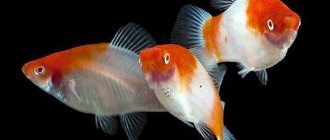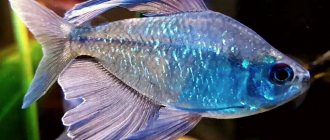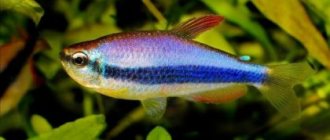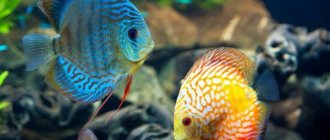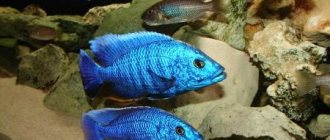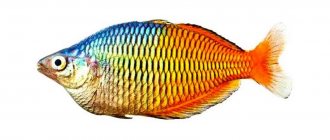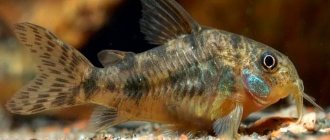5
(8)
Ctenopoma is one of the most interesting representatives of underwater fauna. These are attractive and simple fish, distinguished by their unusual character and unpretentiousness to their living conditions. It is believed that in terms of complexity they are located in the middle, but even a beginner, with the right approach, can successfully keep such a pet at home.
Leopard ctenopoma
(Ctenopoma ansorgii)
Ctenopoma Anzorga
Comfortable water parameters for keeping : 20-24 C, dH 10-30, pH 6.8-8. Light aeration, filtration and regular replacement of up to a third of the volume of water in the aquarium are necessary.
Homeland - western Africa from Senegal to Congo.
The male grows up to 8 cm in length, the female up to 7 cm.
The body is elongated, rather high, flattened laterally. Body color is yellowish-brown with a green or purple tint, the lower part of the body is often yellowish. There are 7 transverse stripes on the sides.
Fish breathe atmospheric air using the gill labyrinth.
To keep the fish you need a large aquarium with a volume of 110 liters or more. The aquarium is equipped with shelters: driftwood, grottoes and thickets of aquarium plants.
The fish are fed with live food, vegetable food and substitutes. Likes live food, including small fish.
Maintenance and care in the aquarium
If desired, even a novice aquarist can keep such pets at home. The main thing is that they have a spacious aquarium, appropriate neighbors and a suitable diet. In general, these fish need the following:
Aquarium . If there is only one individual, then the capacity can be 50 liters (if the variety is miniature). But it’s better to start from 100 liters. For the leopard or gray variety, at least 200 liters are required. The main thing is that the pets have enough space, since ctenopomas are territorial creatures, and if they feel crowded, they will begin to survive competitors in the territory in every possible way;
Water parameters . The aquarist will not notice any particular difficulties with this. The optimal temperature is 23-28 degrees. Stiffness is secondary. Water can be either soft or medium, ranging from 4-15 dGH. Acidity – neutral, 6-8 pH. It is also recommended to make weekly changes, about 20% of the total volume;
Ctenopoma Anzorga
Equipment . A powerful internal or external filter will do. If there is live vegetation, it will be easier to keep the aquarium clean, since they use part of the organic matter as fertilizer. Aeration is not necessary since these animals breathe atmospheric air;
Additions . It is advisable to have a lid. Ctenopomas are not “jumpers”, but it must be taken into account that if they breathe atmospheric air, then it must have the same temperature as water. With the lid on, warm air heated from the aquarium will remain above the surface of the water. Otherwise, the fish will breathe cold oxygen from the room and may catch a cold;
Plants . From the point of view of saturating water with oxygen, they are not needed. However, living flora is a good biological filter. In addition, it divides the aquarium into zones and creates shaded areas in which pets like to sit. Under natural conditions, ctenopomas often live in backwaters, where there are many different snags, algae and plants;
Soil . The best option is small pebbles. But other types of neutral substrate are also suitable;
Decorations . It is important that each individual has its own “house”. They often occupy their own territory (grottoes), in which they spend most of their lives. Therefore, in the aquarium you need to recreate compositions from stones and driftwood, buy some decor, etc.;
Nutrition . Ctenopoma loves a variety of meat foods. This could be frozen bloodworms, tubifex, or brine shrimp. They also prefer live food such as small fish, earthworms, etc. Additionally, you can give dry food from manufacturers. Sometimes scalded salad is added for variety.
(Ctenopoma fasciolatum)
Ctenopoma eight-banded
Comfortable water parameters for keeping : dH 3-10°, pH 6.0-7.0, temperature 24-28 °C. Light aeration, filtration and regular replacement of up to a third of the volume of water in the aquarium are necessary.
Description:
Homeland - western Africa from Senegal to Congo.
The male grows up to 8.5 cm in length, the female up to 7 cm.
The body is elongated, rather high, flattened laterally. The color of the fish depends on its place of origin and can be blue or brown with 8-12 dark transverse stripes on the sides. Fish breathe atmospheric air using the gill labyrinth.
To keep the fish you need a large aquarium with a volume of 110 liters or more. The aquarium is equipped with shelters: driftwood, grottoes and thickets of aquarium plants.
The fish are fed with live food, vegetable food and substitutes.
Characteristics of the area
Zoologist Pellegrin from France classified ctenopoma at the beginning of the twentieth century at the National Museum of Natural History in Paris. After research, he assigned it to the order of African perch and gave it the scientific name ctenopoma acutirostre.
Under natural conditions, leopard fish lives exclusively in the Congo River and its tributaries. It lives in the lower layers of water, so it cannot serve as a commercial fish for the local population. Nocturnal lifestyle: ctenopoma sleeps in algae during the day and goes out hunting at night. She waits for her prey in the thickets, but in excitement she can chase it for a long time.
The body length of the fish does not exceed twenty centimeters; in the wild it is carnivorous. Leopards eat :
- small fish;
- fry;
- aquatic worms;
- invertebrates;
- caviar;
- insects living in water bodies.
This type of African perch is not very popular among aquarists, but there are some exotic lovers who keep only these fish. Ctenopoma began to be kept at home in the 50s.
Dwarf Ctenopoma (Ctenopoma nanum)
Ctenopoma dwarf
Comfortable water parameters for keeping : 22-25 C, dH 4-20, pH 6.5-7.5. Light aeration, filtration and regular replacement of up to a third of the volume of water in the aquarium are necessary.
Description:
Homeland : Zaire and Cameroon.
The male grows up to 7.5 cm in length, the female up to 6.5 cm.
The body is elongated, rather high, flattened laterally. The body is light brown with dark transverse stripes extending to unpaired fins. Fish breathe atmospheric air using the gill labyrinth.
To keep the fish you need a large aquarium with a volume of 110 liters or more. The aquarium is equipped with shelters: driftwood, grottoes and thickets of aquarium plants.
The fish are fed with live food, vegetable food and substitutes.
Reproduction
Ctenopoma almost does not reproduce in aquarium conditions. Some scientists believe that this is not possible at all. Adults usually do not produce offspring. However, these pets reach sexual maturity only by the fifth year.
For dilution you need a container of at least 50 liters. The water should be warm (27 degrees), with floating plants and a lid. In this case, the spawning tank should stand in a dark area of the home.
A pair is selected for reproduction. It is quite difficult to distinguish them. In most species, males are larger. Also, if you look closely, you can see that males have sharper scales, while females have small spots on their fins. There are no other signs.
Under good conditions, the parents assemble a foam nest, where the female lays 400-1000 eggs. The aquarist should not interfere with the process at all and approach the container. If the fish feels threatened or stressed, it will scatter the eggs, break the nest and stop caring for the offspring.
If everything worked out, then after two days the larvae appear from the eggs, and after another two days they begin to swim. The starting food is ciliates, later you can add Artemia naupilia. Despite the large number of eggs, only a small part of the offspring survives, since in a small spawning area the fry compete strongly and eat weak individuals.
Ctenopoma congicum
Ctenopoma congolese
Comfortable water parameters for keeping : 22-25 C, dH 4-20, pH 6.5-7.5. Light aeration, filtration and regular replacement of up to a third of the volume of water in the aquarium are necessary.
Description:
It grows up to 8 cm in length.
The body is elongated, rather high, flattened laterally. It has a reddish-brown color. Fish breathe atmospheric air using the gill labyrinth.
Fish are very picky and, if not kept well, often get sick.
To keep a fish you need a large aquarium with a volume of 150 liters or more. The aquarium is equipped with shelters: driftwood, grottoes and thickets of aquarium plants.
The fish are fed with live food, vegetable food and substitutes.
Diseases
The incidence of Ctenopus is not predictable: there are fish that get sick often, some do not suffer a single disease in their entire lives.
For prevention and to strengthen the immune system, it is sometimes useful to add peat extract to the water.
Sources of infection can be unquarantined fish, cold air and overeating.
To protect the aquarium, you should not immediately release fish just brought from the pet store to the ctenopomas. Covering the aquarium with a lid will help against colds. Problems with digestion and excess weight can be solved with a balanced diet and diet correction.
Leopard ctenopoma (Ctenopoma acutirostre)
Ctenopoma leopardum
Comfortable water parameters for keeping : 22-25 C, dH 4-20, pH 6.5-7.5. Light aeration, filtration and regular replacement of up to a third of the volume of water in the aquarium are necessary.
Description:
Homeland - Central and Western Africa.
It grows up to 20 cm in length.
The body is elongated, rather high, flattened laterally. The color is beige-yellow with dark spots. Fish breathe atmospheric air using the gill labyrinth. The fish is shy, preferring a nocturnal lifestyle.
To keep the fish you need a large aquarium with a volume of at least 200 liters. The aquarium is equipped with shelters: driftwood, grottoes and thickets of aquarium plants.
The fish are fed with live food and substitutes.
Description of appearance
The natural habitat of this fish is Africa, namely the basins of the Congo River, which belongs to the republic of the same name. This animal is endemic, so it cannot be found in other parts of the world. The only exceptions are artificially populated reservoirs. It lives in various bodies of water, ranging from small and fast streams to large ponds with standing water.
Ctenopoma belongs to the labyrinthine family. That is, she has a labyrinth, thanks to which she can breathe atmospheric air. There are some similarities with other members of the family. The fish has a compressed and tall body. The color may vary depending on the variety. However, in any case, this is a formidable weapon, which, in essence, is a means of camouflage.
Life expectancy is 15 years (with good care). The growth rate is slow. It takes several years to reach its maximum size (15 cm).
Ctenopoma kingsleyae
Ctenopoma glaucosa
Comfortable water parameters for keeping : 20-24°C, dH 10-30°, pH 6.8-8. Light aeration, filtration and regular replacement of up to a third of the volume of water in the aquarium are necessary.
Description:
Homeland - western Africa from Senegal to Congo.
Ctenopoma glaucosa in nature reaches up to 20 cm in length, in an aquarium it is less.
The body is elongated, rather high, flattened laterally. The teeth on the posterior edge of the operculum are clearly visible. When catching a fish with a net, special care must be taken: the fish can catch on it with its gill teeth.
The body color is either gray-brown or reddish-brown, the belly is silvery, and there is a black spot on the caudal peduncle.
To keep the fish you need a large aquarium with a volume of at least 200 liters. The aquarium is equipped with shelters: driftwood, grottoes and thickets of aquarium plants.
The fish are fed with live food, vegetable food and substitutes. Likes live food, including small fish.
Compatibility with other fish
Even though these creatures are predators, they can still be successfully kept with other fauna. The main thing is that these are medium or large individuals that can stand up for themselves. For example, ctenopoma gets along with gouramis, tarakatums, ancistrus, panda corydoras, labeo, small and medium-sized cichlids (including angelfish).
Small fish like guppies, neons, and cardinals are not suitable. Also, you should not add slow-moving species with veil fins (for example, goldfish), as they will become the target of attacks from aggressive neighbors. You should also avoid proximity to bully fish such as macropods and macrognathus.
Price
The price of ctenopoma depends on the type of fish. Anzorga is usually the most expensive. They ask for about 1200 rubles for a fish. The Mother of Pearl variety costs a little less, around 1000 rubles. Prices for other types are as follows:
- 700-800 rubles for Blue ctenopoma;
- 550-600 rubles for Eight-Stripe Fish;
- Leopard ctenopoma costs 300-400 rubles;
- approximately 900 rubles for a dwarf individual.
As you can see, the most budget-friendly is the Leopard Ctenopoma. Therefore, it is offered most often. Other species are imported into pet stores less frequently. The price depends partly on the age of the fish. Young animals are sold cheaper. Large, adult fish are sold at a higher price.
Breeding
Breeding the creatures in question is not an easy task. The fact is that the slightest reason for fear or concern prompts the female to begin scattering eggs throughout the aquarium. Therefore, it is very important that the spawning tank (its minimum volume should be 50 liters) is located in a calm environment and must be in semi-darkness. Then the female ctenopoma will carefully leave the eggs in the foam nest, where the males will care for the eggs. And until the fry appear, it is important to prevent the adults from disturbing them. By the way, the fry from the eggs will appear in a day or two, and after two or three days they will begin to swim and feed on their own.
As you can see, care requires certain knowledge about the necessary conditions for funny underwater inhabitants. Compliance with all rules and recommendations, as well as a responsible approach to the maintenance of the considered aquarium inhabitants will allow you to enjoy these interesting creatures.
Cichlid Personality Traits
Golden leopards are rather nervous and aggressive fish. Males of this species are especially intolerant if they find themselves in rather cramped living conditions in a small aquarium. Males will constantly engage in battles.
Considering this feature of the behavior of golden leopards, they must be kept either in the form of a harem, when the flock consists of one male and several females, or a water tank must have a volume of at least 500 liters so that 2 males of this species live in it, and they do not overlap together.
Due to the fairly pronounced aggressiveness of golden leopards, it is not recommended to keep them with other underwater inhabitants, because for males, females are absolute property, and the territory of the aquarium belongs only to them. Golden leopards are especially aggressive during spawning.
Nutrition
Golden leopards are predatory fish that prefer in their diet:
- small fish;
- larvae;
- snails;
- worms;
- tubifex;
- daphnia;
- bloodworm;
- Artemia.
From time to time it is recommended to give the fish beef heart or meat. In addition, they will enjoy eating pieces of crab sticks with pleasure. Cichlids are quite aggressive fish, but if you introduce specialized food in the form of granules into your diet, their character will improve, becoming calmer and friendlier.
